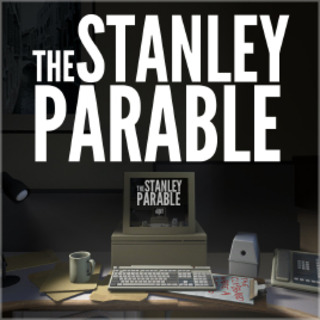The problem with reviewing The Stanley Parable is that it is a game that is much easier to write about than it is to make a video about; in The Stanley Parable you spend most of your time running around an office complex, and so it is difficult to put together enough compelling footage for a five-minute video. The Stanley Parable is much more interesting than I make it sound, but any video-review is nevertheless going to be featuring some sweet corridor action.
In its first astonishing innovation, The Stanley Parable casts you as Stanley, an office worker who one day notices that everyone in his office has disappeared. Aside from a sociopathic failure to notice the world around him, Stanley is also seemingly afflicted with schizophrenia, his adventure narrated by the only other character in the game, called the Narrator, in The Stanley Parable’s second dizzying innovation, an omnipotent being who comments upon Stanley’s actions as you play through the game.
Before I continue with this review, I shall pause for a disclaimer: there is no way of talking about The Stanley Parable without sounding pretentious and wanky. Words like ‘deconstruction’ and ‘interrogate’ and ‘neck-beard’ circle like crows over any writing concerning this game, but the very act of my pointing this fact out lets me get as pretentious as I like so game on.
Now that elephant in the room has been acknowledged, I realise that I have been less than accurate in describing the game and we are only in our fourth paragraph. Though you may play from the viewpoint of Stanley, you never play as him. How could you, you madman, you are sitting comfortably at home with Stanley dangling at the end of your puppet-strings. Stanley has a life, and a wife, and something else ending in –ife, and you fling him from irresponsibly-designed freight lifts, you monster!
You, the player, are the third and final character, and the game spends a significant amount of time musing on the relationship between players and their avatars, which is rather jolly in a beard-stroke-y way. ‘Choice’, narrative, and even the idea of an ‘ending’ in narrative entertainment are The Stanley Parable’s subject matter, and the game does a very good job discussing these themes in a way that is both entertaining and lucid; the whole idea of ‘a’ story in entertainment is commented upon with the introduction of the patented The Stanley Parable Adventure Line™ and some raucous music and the game does a good job of balancing what could be quite a dull subject with amusing and entertaining moments; humour and wit oozes from every line of dialogue and witty whiteboard doodle, the Narrator character deserves to join the pantheon of video game characters alongside GLADoS and Elizabeth from Bioshock Infinite, and you, as if you weren’t already frantically fumbling for your debit card, get to play Portal and Minecraft in a glorious fourth-wall-smash-y sequence. The environments are well designed (as should be expected really, as the developers wrote an ending in which you can explore the prototype designs for Stanley’s office) and you are always aware of the choices you have made to reach one of the game’s endings, and as a result you know what choices to make next to reach a new ending.
While The Stanley Parable is certainly not without its amusing and entertaining moments, they are just that really, moments, interspersed with some top-drawer dialogue undoubtedly, involving what can quite quickly become tedious corridor marathons. The question I asked myself most often as I enjoyed The Stanley Parable’s four-hour run time was ‘Where is the game?’ There are almost none of the activities we have become accustomed to in the last 25 years of videogame development, and the designers have made this decision very deliberately; you do not shoot anyone, there is no HUD display, and, Witcher fans revolt, you can’t have awkward videogame sex with anyone. There are, however, no fetch-quests or escort missions. In fact, absence and lack-ofs are a large part of The Stanley Parable experience; the game will not end, despite my polite requests after hour four of tearing up and down corridors, and while the player is presented with ‘choice’ almost constantly, this choice is proved to be illusory. You will restart the game once you realise that the choice you have made is leading you toward an ending you have already experienced, but the writing makes you understand that even restarting the game is a choice in itself.
As an ostensible purveyor of videos and articles that criticise videogames as both art and products for entertainment, I must ask whether I would recommend The Stanley Parable to anyone not interested in the murky waters of videogame narrative. It would undoubtedly give one plenty of street cred to display The Stanley Parable’s achievements in your Steam profile, but as a piece of entertainment that has at best three or four hours of content is paying full price worth it if you are not writing a PhD on videogame narrative?
The Stanley Parable is an essay in the form of a computer game, but crucially it knows what it is doing, and, ultimately, is there any better way of illustrating and analysing the characteristics of our chosen medium than through the use of the medium itself? All of the criticisms I have of the game are pre-empted by the game, and to pursue them further would make me seem rather petty and stubborn. While some may argue otherwise, for me the game’s problems are ultimately diffused by it referring to them before I have even noticed, and as such I am left with no choice but to declare The Stanley Parable the perfect videogame, and, in tribute to a game with nineteen endings and so simultaneously no endings at all, refuse to give my review its own logical conc-
[embed]https://www.youtube.com/watch?v=omGaRA0niF8[/embed]

